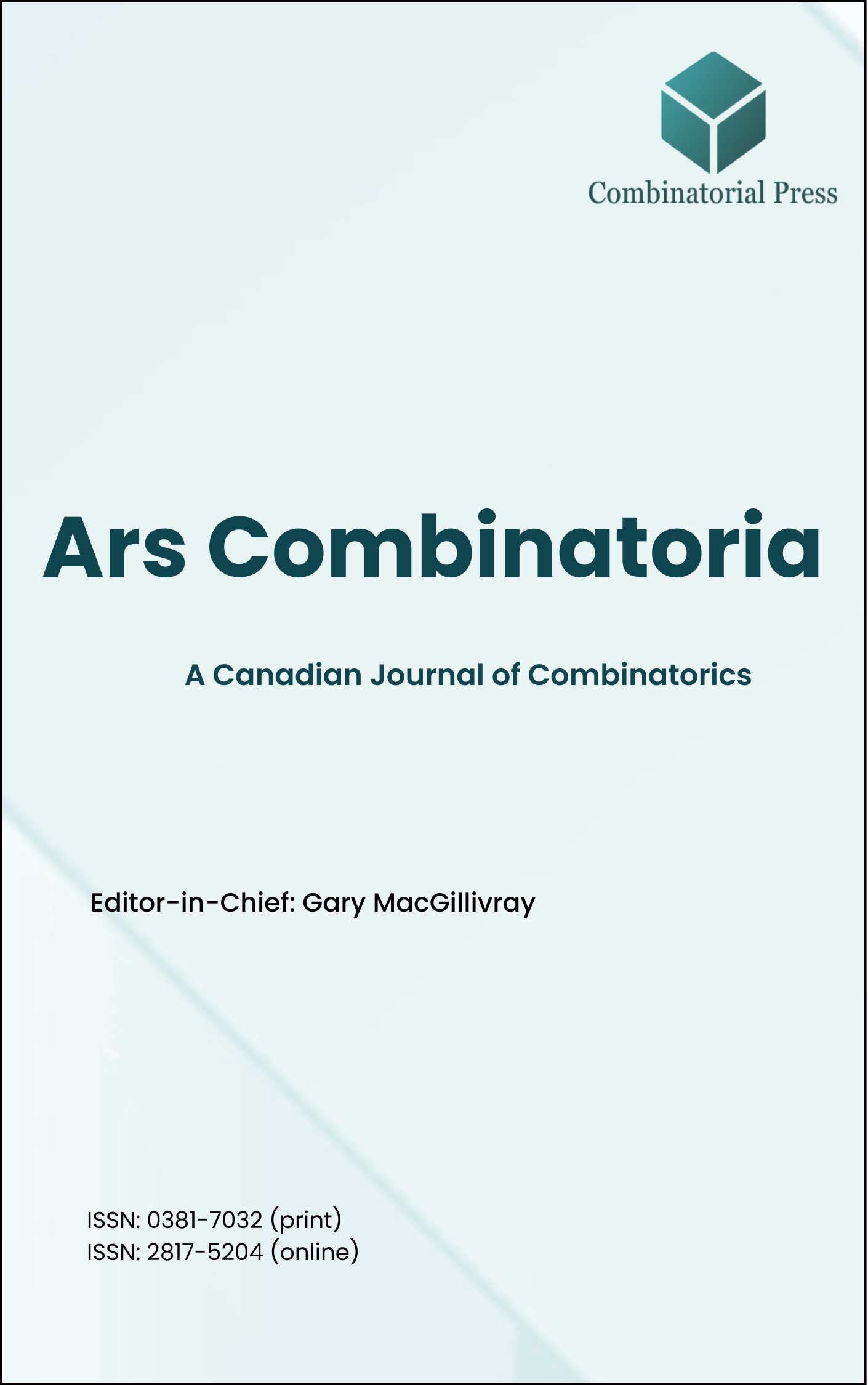
Ars Combinatoria
ISSN 0381-7032 (print), 2817-5204 (online)
Ars Combinatoria is the oldest Canadian Journal of Combinatorics, established in 1976. The journal is dedicated to advancing the field of combinatorial mathematics through the publication of high-quality research papers. From 2024 onward, it publishes four volumes per year in March, June, September and December. Ars Combinatoria has gained recognition and visibility in the academic community and is indexed in renowned databases such as MathSciNet, Zentralblatt, and Scopus. The Scope of the journal includes Graph theory, Design theory, Extremal combinatorics, Enumeration, Algebraic combinatorics, Combinatorial optimization, Ramsey theory, Automorphism groups, Coding theory, Finite geometries, Chemical graph theory but not limited.
Information Menu
- Research article
- Full Text
- Ars Combinatoria
- Volume 046
- Pages: 97-117
- Published: 31/08/1997
An element \(e\) of a matroid \(M\) is called non-binary when \(M\backslash e\) and \(M/e\) are both non-binary matroids. Oxley in \({6}\) gave a characterization of the \(3\)-connected non-binary matroids without non-binary elements. In {4}, we constructed all the \(3\)-connected matroids having exactly \(1\), \(2\) or \(3\) non-binary elements. In this paper, we will give a characterization of the \(3\)-connected matroids having exactly four non-binary elements.
- Research article
- Full Text
- Ars Combinatoria
- Volume 046
- Pages: 77-95
- Published: 31/08/1997
- Research article
- Full Text
- Ars Combinatoria
- Volume 046
- Pages: 33-63
- Published: 31/08/1997
In \([2, 3]\), the authors dealt with the problem of determining the set \(\Gamma(G)\) of all \((a, d)\)-antimagic graphs, \(a, d \in \mathbb{N}\), where the concept of an \((a, d)\)-antimagic graph is a variation of the concept of an antimagic graph given in [4]. A connected graph \(G = (V, E) \in \Gamma=\) set of all finite undirected graphs without loops and multiple edges on \(n = |V| \geq 3\) vertices and \(m = |E| \geq 2\) edges is said to be \((a, d)\)-antimagic iff its edges can be assigned mutually distinct nonnegative integers from \(\{1, 2, \ldots, m\}\) so that the values of the vertices obtained as the sums of the numbers assigned to the edges incident to them can be arranged in the arithmetic progression \(a, a + d, \ldots, a + (n – 1)d\). In [2], the authors obtained some interesting general results on \((a, d)\)-antimagic graphs from \(\Gamma(G)\) by applying the theory of linear Diophantine equations and other number theoretical topics. Applying these general results to wheels \(W_{g , b} = 1 \ast C_{g + b}, g \geq 3, b \geq 1, C_{g + b} =\) cycle of order \(g + b\), and parachutes \(P_{g, b}\) as the spanning subgraph of \(W_{g+b}\) arising from \(W_{g+b}\) by removing \(b\) successive spokes of \(W_{g+b}\), we succeeded in proving that every wheel \(W_{g+b}\) cannot be \((a, d)\)-antimagic and, for every \(g \geq 3\) or \(g \geq 4\), there are the five integers \(b_1 = 2g^2 – 3g – 1, b_2 = g^2 – 2g – 1, b_3 = g – 1, b_4 = g – 3\) and \(b_5 = \frac{1}{2}(g^2 – 3g – 2)\) with the property that the corresponding parachute \(P_{g, b_i}, i = 1, 2, \ldots, 5\), can be \((a, d)\)-antimagic. If \(\Gamma_i(P)\) denotes the set \(\Gamma_i(P)= \{P_{g, b_i} \in \Gamma(P) \mid g \geq 3\}, i = 1, 2, \ldots, 5\), the main result in [2] says that \(\Gamma_3(P) = \{P_{3, 2}, P_{4, 3},\ldots, P_{8,7}, P_{10,9}, P_{11, 10}\}\) and \(\Gamma_4(P) = \{P_{4, 1}, P_{5, 2}, \ldots, P_{10, 7}\}\). Concerning \(\Gamma_1(P), \Gamma_2(P)\) and \(\Gamma_5(P)\) the authors conjecture that they are infinite. Here, we continue [2] and prove the conjecture given in [2] for \(\Gamma_1(P)\) and \(\Gamma_2(P)\). Instead of \(\Gamma(P)\) we prove the infiniteness of \(\Gamma'(P) = \{P_g,\frac{1}{3} (2g^2 – 5g – 3) \in \Gamma(P) \mid g \equiv 0(3) \text{ or } g \equiv 1(3)\}\). Furthermore, we succeed in showing the existence of integers \(b_{min} \in \{\frac{g^2 – 3g – 2}{2}, \frac{g^2 – 4g – 3}{3},\frac{g^2 – 5g – 4}{4}, \frac{2g^2 – 7g – 5}{5}, \}\) with respect to \(g \geq 26\) with the property that the parachute \(P_{g, b}\) is not \((a, d)\)-antimagic for each positive integer \(b \leq b_{min}\). The immediate consequence of this fact is that for every \(g \geq 26\) there are at most \(8\) different integers \(b \geq b_{min}\) such that the corresponding parachute \(P_{g, b}\) could be \((a, d)\)-antimagic.
- Research article
- Full Text
- Ars Combinatoria
- Volume 046
- Pages: 25-32
- Published: 31/08/1997
Let \(\gamma(G)\) be the domination number of a graph \(G\). The bondage number \(b(G)\) of a nonempty graph \(G\) is the minimum cardinality among all sets of edges \(X\) for which \(\gamma(G – X) > \gamma(G)\).
In this paper we show that \(b(G) \leq \Delta(G)\) for any block graph \(G\), and we characterize all block graphs with \(b(G) = \Delta(G).\)
- Research article
- Full Text
- Ars Combinatoria
- Volume 046
- Pages: 3-24
- Published: 31/08/1997
- Research article
- Full Text
- Ars Combinatoria
- Volume 046
- Pages: 267-276
- Published: 31/08/1997
We report on difficulties in applying traditional clustering procedures to discrete data. We describe a graph theoretical approach in clustering binary vectors where the number of clusters is not given in advance. New clustering procedures are combined from several algorithms and heuristics from graph theory.
- Research article
- Full Text
- Ars Combinatoria
- Volume 046
- Pages: 65-75
- Published: 31/08/1997
- Research article
- Full Text
- Ars Combinatoria
- Volume 037
- Pages: 157-173
- Published: 30/06/1994
- Research article
- Full Text
- Ars Combinatoria
- Volume 045
- Pages: 276-286
- Published: 30/04/1997
A coin tossing game — with a biased coin with probability \(q\) for the tail — for \(n\) persons was discussed by Moritz and Williams in \(1987\), in which the probability for players to go out in a prescribed order is described by what is commonly called the “major index” (due to Major MacMahon), which is an important statistic for the permutation group \(\mathcal{S}_n\). We first describe a variation on this game, for which the same question is answered in terms of the better known statistic “length function” in the sense of Coxeter group theory (also called “inversion number” in combinatorial literature). This entails a new bijection implying the old equality (due to MacMahon) of the generating functions for these two statistics.
Next we describe a game for \(2n\) persons where the ‘same’ question is answered in terms of the Coxeter length function for the reflection group of type \(B_n\). We conclude with some miscellaneous results and questions.
- Research article
- Full Text
- Ars Combinatoria
- Volume 045
- Pages: 271-275
- Published: 30/04/1997
The achromatic index of a graph \(G\) is the largest integer \(k\) admitting a proper colouring of edges of \(G\) in such a way that each pair of colours appears on some pair of adjacent edges. It is shown that the achromatic index of \(K_{12}\) is \(32\).





